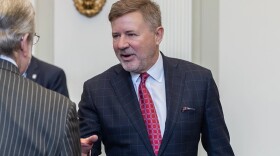On a cool spring morning at the Chickasaw National Recreation Area, park ranger Megan Wilkins said there’s no telling how long the day’s work will take. It all depends on how cooperative 10 giant land mammals are feeling on this particular morning.
Luckily, most of the National Park Service’s smallest herd of bison are feeling cooperative. Nine of them are loaded onto a trailer, taken across the recreation area, and unloaded into their new pasture in about an hour. The more stubborn bison will join her herd when she’s ready.
It’s the first time the herd has been moved since 1934, when the first group of bison was brought to what was then called Platt National Park.
Wilkins said over the years, woody overgrowth has begun to take over the original pasture. Since the bison can’t graze on that, the park rangers needed to find them somewhere new. They settled on a 42-acre plot of land on the other side of the recreation area.
“The new pasture’s like half the size of the old one, but it's got more grass for them to graze on. So we'll be able to get into that old pasture and start doing some prairie restoration work and get some more grass growing in there,” Wilkins said.
This move was several years in the making. Plans started in 2016, but the COVID-19 pandemic delayed the bureaucratic processes needed to approve the project. Wilkins said the most recent setback was also due to unforeseen circumstances.
“Last summer we had that drought so we had to hold off on fence construction because we couldn't do the welding. We just said, ‘You know what? The bison have been in that pasture for 89 years. If they need to be in there for one more, that will be okay,’” Wilkins said.
Former superintendent of the recreation area, Bill Wright, worked on moving the bison before he retired at the end of last year.
“It's one of those projects I was hoping we’d finish before I retired, but I was like, you know what? You get to start a lot of stuff in this organization that other people finish. And I knew these guys would finish,” Wright said.
The park rangers are tasked with more than taking care of the bison; they also educate visitors about their history and cultural significance.
Park ranger and chief of interpretation for the recreation area, Ron Parker, said the park rangers work to share the story of the bison - from the time before European colonization in the Americas to today.
“It’s a great conservation story. We nearly lost the animal. And it's been through those recovery efforts that once again, the nation has thriving herds. Certainly not the numbers that were here historically. Pre European settlement, we're talking 30 or 60 million. And today, you know, the herd size, you know, it's just a fraction of that,” Parker said.
Parker said acknowledging mankind’s responsibility for the current state of the bison is an important part of the story the park rangers share with visitors.
“We try to tell that story that men can have great impact. In this case, you know, initially nearly pushing that animal to extinction. And then man can have that role in helping recover. So both, you know, both positive and negative impacts men can have,” Parker said.
Another important part of the story is the connection between the bison and Native American communities, both historically and to this day. The recreation area regularly gives bison to local tribes; most recently the Choctaw Nation.
Wright said over the years, the bison have become part of the larger community. That’s why the visitors’ experience was also taken into account when planning for the new pasture.
“I wanted to make sure they were visible. The public needs to be able to see them. These bison have a huge cultural impact here. I mean, people bring their grandkids and their grandkids now are adults and they bring their grandkids. And my grandfather brought me down here when I was a kid to see them,” Wright said.
Wilkins said the goal is to restore the original pasture so the bison can be rotated between two pastures once or twice a year. The last bison will join the rest of the herd soon. For now, the others will start exploring their new home.
KGOU is a community-supported news organization and relies on contributions from readers and listeners to fulfill its mission of public service to Oklahoma and beyond. Donate online, or by contacting our Membership department.








